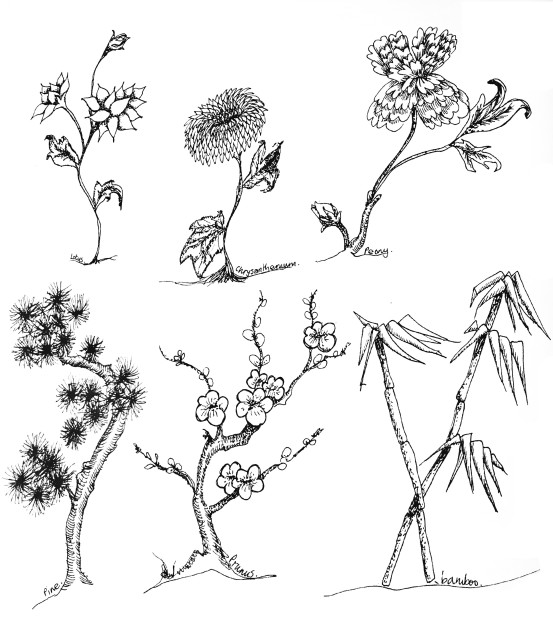The ancient belief was that a hare sat on the moon pounding the drugs of immortality at the foot of a cassia tree. Whilst on earth mere mortals knew that the souls of Gods lived on in trees and that the penalty for cutting down trees was certain death. Perhaps if more attention was paid to these ancient myths the droughts, floods and famine would not be here today. Does celadon really react to poisonous substances? Nigel Wood, lecturer at the Royal College of Art researching into glazes, will perhaps discover that there is a grain of truth in this also. Legend and mythology abound as art motives on porcelain. Below are listed some of the symbols and their meanings.
ARTEMESIA - One of the eight precious things. Drives away disease. Hung over a door it will disperse evil influences. Often found on blue and white and famille verte objects from the Kangxi period in the place of the Nina hao.
BAMBOO - One of the 'Three Friends of Winter', often depicted together with pine and prunus. Emblem of longevity.
BAT - Emblem of happiness. Usually painted red, the colour of joy. The Wu Fu, or five bats of happiness, stand for the five blessings: old age, wealth, health, virtue and natural death.
CHRYSANTHEMUM - Together with plum, peony and lotus symbolizes the four seasons. It is the emblem of autumn and symbol of joviality.
COCKEREL - Protection against bad astral influences. It also frightens ghosts away at sunrise by its crowing.
CRANE - An emblem of longevity and superhuman wisdom. Cranes are the flying steeds of the immortals, their other celestial locomotion being clouds. The crane is also believed to carry the souls of the dead to the Western Heaven. Cranes flying into the sky symbolize a rise in status.
DEER - The only animal able to find the sacred fungus of immortality. Represents official emolument. The God of Longevity usually depicted mounted on a stag or standing by his side.
DOUBLE-GOURD - A microcosm containing heaven and earth. Scrolling double-gourds, bats and the character shou show a wish for long life and many sons.
DRAGON - Imperial emblem of the Emperors from the Han period, the coat of arms being two dragons contesting the fiery pearl. Guardian of treasures, also emblem of vigilance. Both Buddhist and Daoist legends abound with stories of this powerful, benevolent creature described beautifully by Okakura, a Japanese writer: 'Hidden in the caverns of inaccessible mountains, or coiled in the unfathomed depths of the sea, he awaits the time when he slowly rouses himself into activity. He unfolds himself in the storm clouds; he washes his mane int he blackness of the seething whirlpools. His claws are in the fork of the lightning, his scales begin to glisten in the bark of rain-swept pine trees. His voice is heard in the hurricanes, which, scattering the withered leaves of the forest, quickens to a new spring.' There is a theory that during the Yuan and Ming periods decoration of a five-clawed dragon was for imperial use only. Certain objects have had the fifth claw carefully removed, thereby downgrading the status of the piece, perhaps because these objects had been stolen from the palace. However, there are arguments against this theory.
DUCK - Symbol of conjugal fidelity. Pairs of Mandarin ducks swimming amongst waterweeds are particularly favoured as a design on 14th century blue and white Chinese porcelain.
HORSE - Emblem of speed and perseverance. The legend of the eight horses of Mu Wang often used as a decorative motif.
LIONS - Not indigenous to China, however, in the wake of Buddhism lions were seen as having superhuman strength as protectors and mounts of holy beings. Guardians of Buddhist temples. Sometimes called Dogs of Fo, they are emblems of valour and energy. Often depicted in pairs pursuing a brocaded ball which represents the jewel of the law, a pearl, or an egg enclosing a cub.
LOTUS - Symbol of purity and perfection. Emblem of summer and fruitfulness. One of the eight treasures of Buddhism, also held in great esteem by Daoists.
PEACH - The fairy fruit. The fruit that gave immortality to the Immortals and was the elixir of life to the Daoists. Emblem of marriage. Symbol of spring and immortality. The peach tree of the Gods was said to blossom once every 3000 years and the fruit of eternal life took another 3000 years to ripen.
PEACOCK - Emblem of beauty and dignity. The tail feathers used from the Ming dynasty to show official rank.
PEARL - The concrete essence of the moon. Emblem of genius in obscurity, also a sign of beauty and purity.
PEONY - King of flowers. An omen of good fortune. Emblem of love and affection and feminine beauty. The sign of spring.
PHEASANT - The imperial symbol of authority, also used as a symbol of office.
PHOENIX - Emblem of the Empress and of beauty. Only appears in time of peace and prosperity. Ranks second of the four supernatural creatures, the dragon being the first, the unicorn third and the tortoise fourth. A train of small birds is always in attendance when the phoenix flies.
POMEGRANATE - Symbos of fertility and numerous male progeny as it is full of seeds.
THREE-LEGGED TOAD - Existed only on the moon, which it swallowed during the eclipse. Symbol of the unattainable. Liu Hai, an immortal, apparently possessed a three-legged toad, see catalogue number 89.
QUAIL - Emblem of courage on account of its pugnacious character.
WILLOW - Buddhist symbol of meekness. Also a sign of spring. Believed to have the powers to expel demons.
SYMBOLISM SIGNS AND PORTENTS
by Anita Gray
2018年1月15日

